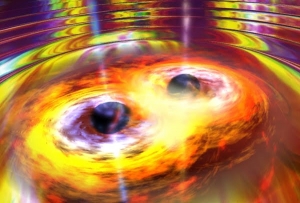3rd observation of gravitational waves has proved existence of unexpected black holes
01-06-2017
The Advanced LIGO research consortium (in which some NCBJ scientists participate) has reported the 3rd instance of direct observation of gravitational waves. The logged waves were emitted just before two black holes merged into a single spinning larger hole of a mass 49 times larger than the mass of our Sun and about 3 billion light years away the Earth.
Gravitational waves are small disturbances propagating through our space-time. Recently they were experimentally observed for the 3rd time ever. Just like in the two previous observations made in 2015, the waves were emitted in result of a merger of two black holes into a single larger spinning black hole. The new black hole is about 3 billion light years away the Earth i.e. twice as far as the holes observed in the two previous cases. Its mass is 49 times larger than the mass of our Sun, a value between values estimated for the holed observed in the two previous cases (21 and 62 Sun masses). Power of gravitational waves emitted just before each of these hole merger events was larger than total power emitted in the form of electromagnetic radiation by all stars and galaxies in the observable Universe.
The recent observation was done during the current run of the Advanced LIGO detector composed of the two interferometers operated in Hanford (Washington) and Livingston (Louisiana) in the USA. The run started on November 30, 2016 will be continued till summer 2017. That time Advanced Virgo, an European interferometer based near Pisa, Italy will start to acquire scientific data (after it was successfully started-up at the beginning of May). As soon as Advanced Virgo joins Advanced LIGO, a network composed of three interferometers will be capable to detect even weaker gravitational waves and to more precisely measure parameters of their origins.
The 3rd observation of gravitational waves took place on January 4, 2017. The signal in question (coded as GW170104) was carefully analysed by both LIGO and Virgo scientific collaborations composed of about 1,200 researchers from more than 100 research institutions located on 4 continents. The same collaborations experimentally discovered gravitational waves in September 2015, and made another observation of such waves a few months later.
“The 3rd observation evidenced unexpected existence of a population of black holes of masses larger than 20 Suns” – said Jo van den Brand from Nikhef and VU University of Amsterdam, spokesman of the Virgo collaboration composed of more than 280 researchers – “Cooperation of the LIGO / Virgo teams helped to observe really amazing events that took place billions of years ago”.
The recent observation has also brought some clues on spatial orientation of both rotation axes around which two mutually approaching black holes were spinning before merging. Each black hole may spin around an arbitrarily oriented axis, not necessarily perpendicular to the plane in which one black hole orbits around another one. Results of analysis of the acquired data indicate that axis of rotation of at least one involved black hole was not perpendicular to the plane in which both holes were orbiting. That in turn gives some clues on how the pair of black holes was created.
The Virgo collaboration includes POLGRAW, a group of Polish scientists from Polish Academy of Sciences Mathematics Institute, Polish Academy of Sciences Copernicus Astronomical Centre, NCBJ, AGH University of Science & Technology in Cracow, University in Białystok, Jagiellonian University in Cracow, Copernicus University in Toruń, Warsaw University, Wrocław University and Zielona Góra University.
„Our task was to analyse data acquired by the LIGO detectors operated in the USA, to study astrophysical sources of gravitational waves, to develop theoretical models of the waves, and to participate in development of the Virgo detector” – said Professor Andrzej Królak from Polish Academy of Sciences Mathematics Institute and NCBJ, member of the Virgo project Management Board.
Polish scientists have developed background for numerous algorithms and methods useful to detect and estimate parameters of gravitational waves emitted by double systems (Professors Andrzej Królak and Piotr Jaranowski), contributed to development of a precise method of modelling of such waves (Piotr Jaranowski and Andrzej Królak), made simulations showing that double systems of black holes are the best candidates for detection of sources of gravitational waves by the LIGO-Virgo detector (Professor Tomasz Bulik), studied astrophysical properties of double systems (D.Sc. Michał Bejger, Dr. Izabela Kowalska-Leszczyńska, D.Sc. Dorota Rosińska), and looked for optical bursts that might accompany emission of gravitational waves (Dr. Adam Zadrożny).





